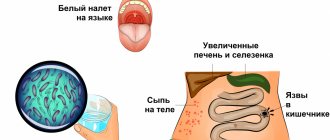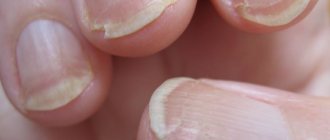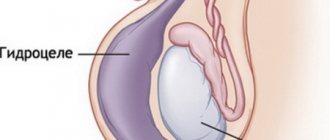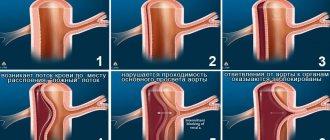What is hydrocele?
Hydrocele, also known as hydrocele or hydrocele, is an accumulation of fluid in the membranes of the testicle, which leads to enlargement of the scrotum, and sometimes swelling in the groin area.
There is isolated hydrocele of the testicular membranes, when the fluid surrounds the testicle and cannot flow into other cavities, and communicating hydrocele.
A communicating hydrocele differs in that hydrocele can flow into the abdominal cavity and back through a special duct - the vaginal process of the peritoneum. Hydrocele of the testicle is often combined with an inguinal hernia.
Lymphocele is a concept close to testicular hydrocele, meaning the accumulation of lymph in the membranes of the testicle, which occurs when the lymphatic vessels of the testicle are damaged or compressed. Typically, lymphocele is accompanied by stagnation of lymph in the testicle and its membranes - lymphostasis.
What it is?
Dropsy is a pathology that causes the scrotum to fill with fluid. While the boy is in the mother's womb, his testicles are located in the abdominal cavity. They descend only shortly before the eighth month of pregnancy. The testicles take with them a thin film of connective abdominal tissue, resulting in something resembling a pocket.
With normal development, it closes before the baby is born or after a couple of months. If this does not happen for some reason, then liquid accumulates in the pocket.
Communicating hydrocele of the testicle in children. What is the mechanism of formation of a communicating hydrocele?
The term communicating hydrocele or communicating hydrocele means that between the cavity surrounding the testicle and the abdominal cavity there is a communication - an open vaginal process of the peritoneum, through which fluid from the abdominal cavity enters the scrotum and back.
During fetal development, the testicle descends into the scrotum through the inguinal canal. Together with it, the processus vaginalis descends into the scrotum - an outgrowth of the peritoneum that envelops the testicle and, thus, forms the two shells closest to the testicle.
By the time of birth or during the first months of life, normally the processus vaginalis of the peritoneum is overgrown, and the connection between the testicular membrane and the abdominal cavity disappears. Thus, neither peritoneal fluid nor abdominal organs can penetrate the cavity where the testicle is located. The lower part of the processus vaginalis of the peritoneum forms a slit-like cavity around the testicle, which, in case of dropsy, serves as a container for dropsy fluid.
The main cause of communicating hydrocele of the testicle is non-closure of the processus vaginalis of the peritoneum, which serves as a duct for moving peritoneal fluid from the abdominal cavity into the membranes of the testicle.
Causes
The classification of testicular hydrocele depends on the reasons that provoked the formation of the pathology. Hydrocele of the testicular membranes can be congenital or acquired.
Congenital hydrocele is recognized in approximately eighty percent of infants. The reasons for the formation of dropsy are a failure in the development of the testicles. As the child grows, the testicle descends from the abdominal cavity along the inguinal canal, which is enveloped by the vaginal process of the peritoneum. Over the course of several months, if the processus vaginalis does not heal, fluid from the abdominal cavity overflows into the membranes of the testicle. It happens that hydrocele of the testicular membranes does not require surgical intervention and disappears on its own. Naturally, such changes in fetal development do not occur without a reason.
The main reasons for such violations:
- use of certain medications (certain medications that a woman takes during pregnancy disrupt the development of the internal organs of the fetus);
- bad habits of the baby’s mother (abuse of alcoholic beverages and smoking, provokes the development of pathologies and complications in the development of children, and can also cause dropsy);
- heredity (dropsy of the testicular membranes is often formed due to the genetic predisposition of the child; the disease can pass from one generation to another);
- rubella disease (if a pregnant woman becomes infected with rubella, there is a great threat to the baby’s health and leads to severe developmental disorders, so doctors often recommend an abortion).
Secondary testicular hydrocele, or reactive hydrocele, which in most cases is characterized by a non-communicating mechanism of development, can occur in the following cases:
- testicular torsion;
- injuries to the scrotum area;
- tumor of the testicle and its appendages;
- complication of infectious diseases (ARVI, influenza), including children's (for example, mumps);
- various inflammatory diseases of the testicle and its appendages (orchitis, epididymitis, etc.);
- filariasis (damage to the lymph nodes caused by helminths) and other diseases leading to damage to the lymphatic system
- complication after surgical operations - hernia repair, varicocelectomy (removal of dilated veins of the testicle and spermatic cord) - due to damage to the structure of the spermatic cord, in particular the lymphatic vessels, while the absorption of fluid produced by the vaginal membrane is impaired;
- severe cardiovascular failure.
These diseases can cause blood to accumulate in the testicle and lead to the appearance of dropsy. With the exception of the origin of dropsy of the testicular membranes, doctors divide the disease into 2 subcategories, according to the nature of the disease: acute and chronic form.
According to the form of the flow, the following types of hydrocele are distinguished:
- acute;
- recurrent;
- chronic.
Classification according to the type of closure of the vaginal duct:
- Communicating dropsy. With it, fluid passes freely between the abdominal cavity and the scrotum.
- Non-communicating (isolated). Looks like a cyst. The fluid in the scrotum is under pressure.
Causes of non-fusion of the peritoneal process.
Many theories explain non-fusion of the processus vaginalis of the peritoneum. Thus, in the open vaginal process of the peritoneum, smooth muscle fibers were found, which are not found in the normal peritoneum. Smooth muscles can prevent fusion of the peritoneal process.
According to our data, there is a higher incidence of reported hydrocele in children born after a pathological pregnancy with threatened miscarriage, as well as in premature children.
Another reason lies in the increase in intra-abdominal pressure, which is observed during resuscitation measures, with frequent restlessness of the child or during physical exercise.
How to cure the disease?
Hydrocele, which developed against the background of acute inflammatory processes in the scrotum, usually disappears quite quickly after adequate therapy. Treatment is prescribed in accordance with the specific reasons that caused the pathology.
As for congenital disease , it develops due to some individual characteristics of the intrauterine development of the fetus. It is not necessary to treat it with aggressive methods, unless it threatens the child’s health. In most cases, congenital pathology is eliminated on its own, without third-party intervention.
What does communicating hydrocele of the testicular membranes and an inguinal hernia have in common?
An inguinal or inguinal-scrotal hernia occurs in children with a wide, unclosed processus vaginalis of the peritoneum. Not only fluid from the abdominal cavity penetrates into the open vaginal process of the peritoneum, but also movable organs of the abdominal cavity (loop of intestine, strand of omentum, appendages in girls, etc.) can emerge, which characterizes an “oblique” inguinal or inguinoscrotal hernia.
In adults, inguinal hernias differ from those in children. They are associated with defects in the muscles and tendons of the anterior abdominal wall that occur during exercise. In childhood, such hernias are extremely rare. Therefore, operations for inguinal hernias in children and adults are performed using various methods.
Diagnostics
It is necessary to distinguish testicular hydrocele from an inguinal hernia, which also causes an enlargement of the scrotum. If you have an inguinal hernia, you can use your finger to reduce the hernia. During reduction, a characteristic “gurgling” sound is heard, and the volume of the scrotum decreases. With testicular hydrocele, when the duct communicates with the abdominal cavity, palpation also causes a decrease in the volume of the scrotum, but no characteristic sound is observed, and the decrease in volume occurs much more slowly.
Also, a research method such as diaphanoscopy helps in diagnosing dropsy. The essence of this method is that the scrotum is illuminated using a flashlight. Since the liquid transmits light well, all structural formations in the scrotum are clearly visible. If pus, blood, or a tumor formation accumulates in the scrotum, they do not allow light to pass through, and the scrotum is poorly visible. In difficult cases, when a tumor disease cannot be excluded, an ultrasound examination of the scrotum is performed, in which, in case of testicular hydrocele, free fluid is determined.
Hydrocele of the testicular membranes in newborns and young children. Isolated hydrocele of the testicle.
In newborns and infants, hydrocele of the testicle in 80% of cases is (or becomes during the first months of life) isolated from the abdominal cavity and goes away on its own within 6-12 months. Isolated hydrocele of newborns is associated with birth trauma, peculiarities of hormonal status and the state of lymph outflow from the scrotum in children 1 year of age.
Isolated testicular hydrocele is often bilateral. Often the dropsy increases and becomes tense. In cases of intense hydrops, punctures are usually performed to remove fluid from the membranes of the testicles. Surgical treatment is usually not indicated.
Isolated hydrocele of the testicular membranes in boys over 3 years of age.
Isolated hydrocele of the testicle over the age of three often occurs after injury or inflammation. There are also cases of transformation of a communicating dropsy into a non-communicating one, due to the closure of the lumen of the peritoneal process from the inside, for example, by a strand of the omentum.
What complications can occur after removal of testicular hydrocele?
The likelihood of postoperative complications is extremely low and amounts to 1-2%. These include:
- swelling of the scrotum;
- change in the shape of the scrotum;
- infertility (in case of damage to the spermatic cords).
As practice shows, after surgery, testicular hydrocele no longer develops. Unfortunately, effective conservative treatment methods do not exist today. If you detect the slightest suspicion of a hydrocele developing in a newborn boy, you should contact your treating specialist.
How common is testicular hydrocele and how often is surgery required?
Hydrocele of the testicular membranes in newborns and boys in the first year of life occurs in 8-10% of cases. In 80% of cases it is isolated and goes away on its own. In 20% of children, surgery is performed after one year.
Communicating hydrocele of the testicle in children after 1 year 0.5-2.0%. In 95% of cases, surgical treatment is indicated.
Lymphocele and testicular lymphostasis in adolescents after operations for varicocele account for from 1% to 25% of all surgical interventions, depending on the type of operation and surgical technique (on average about 10-12%). In 80% it is amenable to conservative treatment. In the remaining 20%, surgical treatment is indicated.
Hydrocele and lymphocele after surgery for inguinal hernia in adolescents - statistics are the same as in adults 3-10%. Surgical treatment is often performed.
How to treat hydrocele? Operative and conservative methods
Whether a child requires surgery depends on the shape of the testicular hydrocele. If the pathology is congenital, then a wait-and-see approach is usually chosen under the supervision of a doctor. In 80-85% of cases, the disease goes away on its own in the first 1.5 years of life.
In the acute form of hydrocele, the underlying disease that caused the hydrocele is treated. In the case of a severe form of the disease, a puncture is performed and the fluid is removed, but this gives only temporary relief, because the cause of the accumulation of water must be eliminated. Source: A.V. Grinev, S.I. Nikolaev, V.E. Serdyutsky, D. S. Efremenkov New technologies in the treatment of hydrocele in adults and children // Bulletin of the Smolensk State Medical Academy, 2003, No. 5
How to diagnose hydrocele?
The disease usually occurs with obvious external manifestations - swelling (increase in volume) of the scrotum on one or both sides. Scrotal enlargement may decrease or disappear at night when the child is in a horizontal position, and reappear when awake. This is evidence in favor of communicating hydrocele of the testicular membranes. Enlargement of the scrotum is sometimes also observed with tension or “inflating” of the abdomen.
Subjective sensations are insignificant. Complaints are rare. In case of acute, infected or tense dropsy, pain may be observed.
To establish the correct diagnosis, ultrasound is used - ultrasound examination of the inguinal canals and scrotal organs and duplex examination of testicular vessels.
Ultrasound often makes it possible to detect a problem from the other side - for example, an inguinal hernia or spermatic cord cyst that is invisible during examination.
Sometimes enlargement of the scrotum and groin area appears and disappears, and may be absent upon examination by a doctor. Then a photograph taken when a swelling appears in the scrotum or groin area, taken by the parents, helps resolve the issue of diagnosis.
Symptoms of hydrocele in boys
Pathology, as a rule, is discovered completely by accident by a pediatrician during preventive examinations or by parents during daily hygiene procedures. Visually, you can notice an enlargement of the scrotum on one or both sides. In an isolated form of the disease, the volume of tissue increases gradually; in the case of a communicating pathology, the size may vary depending on the position of the body, motor activity and the location of fluid accumulation. Hydrocele of the testicles itself does not cause pain, discomfort, itching or other unpleasant symptoms in the child.
Babies are often capricious, toss and turn, and restless, and older children may complain of discomfort when walking, running, a feeling of heaviness and fullness in the groin. In some cases, hydrocele is accompanied by the formation of a unilateral or bilateral inguinal hernia.
Diseases and circumstances that are often accompanied by the occurrence of hydrocele
- Cryptorchidism (undescended testicle)
- Hypospadias
- False hermaphroditism
- Epispadias and exstrophy
- Ventriculo-peritoneal shunt
- Prematurity
- Low birth weight
- Liver diseases with ascites
- Defects of the anterior abdominal wall
- Peritoneal dialysis
- Burdened heredity
- Cystic fibrosis
- Inflammatory diseases of the scrotum leading to the development of reactive hydrocele
- Testicular torsion
- Injury
- Infection
- Previous operations affecting the lymphatic system of the testicle
Prevention
At the stage of planning and maintaining pregnancy, the expectant mother needs to carefully monitor her health, promptly eliminating infectious and inflammatory diseases. To prevent a newborn child from developing hydrocele of one or both testicles, it is necessary:
- regularly examine the baby’s genitals and properly care for them;
- avoid hypothermia and overheating of the scrotum;
- teach children the rules of personal hygiene to avoid infection;
- prevent the development of obesity in children;
- stimulate adequate physical activity.
In the case of a congenital form of hydrocele, the child should be under regular supervision of a urologist or surgeon until complete recovery or surgery.
Hydrocele of the testicle is one of the diseases that can cause male infertility. Do not ignore a visit to a urologist-andrologist; at the slightest sign of a problem, make an appointment with an experienced specialist at the SM-Doctor clinic.
Treatment of hydrocele (hydrocele) and lymphocele without surgery. Duration of observation.
Hydrocele in children under 1 year of age requires observation by a pediatric urologist-andrologist. If fluid accumulates and tension appears in the membranes of the testicle, punctures are performed to remove hydrocele. Sometimes repeated punctures are required.
Communicating hydrops with a narrow peritoneal process is usually observed up to 2 years.
Observation is also required for traumatic dropsy, which occurs as a result of a bruise without compromising the integrity of the testicle. As a rule, 3 months are enough to assess the dynamics of the process and, if there is no improvement, prescribe surgical treatment. The same applies to hydrocele formed after inflammation.
The most difficult is the management of patients with lymphocele that forms after surgical treatment of an inguinal hernia and varicocele. In this case, prematurely performed surgery has little chance of success. For 6-12 months, it is necessary to monitor the condition of the testicle according to ultrasound and duplex examination of the scrotal organs in order to assess the dynamics of the process and the effectiveness of the therapy.
Methods for diagnosing the disease
A boy with such a problem should be shown to a pediatric urologist. At the initial consultation, the doctor collects an anamnesis of the child’s life and information about the course of his mother’s pregnancy. Then he examines the boy in a lying and upright position. This allows you to distinguish communicating dropsy from isolated dropsy. After this, the small patient needs to undergo an examination, which consists of the following procedures:
- Diaphanoscopy - transillumination of the scrotum with a special flashlight. If the disease is not complicated, the testicular membranes have a uniform color.
- Ultrasound of the groin area, which allows you to see the presence of a reported type of disease, determine the exact amount of fluid, and exclude tumors and other diseases of the scrotum.
- Scrotal biopsy – indicated when there is doubt about the diagnosis. With its help, the structure of the selected area is studied at the cellular level, malignant processes or benign formations are identified.
- A general blood test makes it possible to exclude infection and inflammation.
When is surgery performed for hydrocele?
- Operations for communicating hydrocele of the testicle are most often performed in children aged 2 years.
- From 1 to 2 years, operations for communicating hydrops are performed if:
- combined dropsy and inguinal hernia
- when the volume of the scrotum clearly changes with changes in body position
- dropsy increases, causing discomfort
- infection joins
- Surgeries for post-traumatic dropsy – 3-6 months after injury.
- Lymphocele that occurs after surgery for an inguinal hernia or varicocele is operated on 6 to 18 months after the appearance of fluid in the membranes of the testicle.
Treatment without surgery: clinical recommendations
An operation to remove testicular hydrocele is the only way to eliminate this pathology in a child. Doctors warn that folk remedies and dietary supplements can produce unpredictable effects. Only those children who have recovered by the time they reach 1.5 years of age can do without surgery.
Of course, many parents are afraid that the boy will remain infertile due to the presence of such a disease. Yes, overheating of the testicles can disrupt their hormonal function and reduce sperm quality. However, in early childhood (up to 3 years old) this is not critical, because all body systems are still just forming and starting to work correctly. If the doctor suggests observing the child and not performing surgery for now, do not be alarmed, because this is generally accepted practice.
Surgery for hydrocele (hydrocele). Surgical options.
The type of operation depends on the age of the patient and the characteristics of the dropsy.
Surgery for communicating hydrocele of the testicle. Operation Ross.
For communicating dropsy, as a rule, the Ross technique is used - isolation from the elements of the spermatic cord, excision and ligation of the internal inguinal ring of the peritoneal process, as well as the formation of a “window” in the membranes of the testicle. The operation is performed through a small incision in the groin area.
The operation is delicate, requiring good technique - careful and careful preparation while preserving all the anatomical formations of the spermatic cord - the vas deferens and testicular vessels, as well as the inguinal nerve.
Laparoscopic operations are sometimes used for testicular hydrocele, but the morbidity, risk of relapses and complications when using them are higher, and the duration of anesthesia is longer, so they are not widely used.
Operations for isolated hydrocele of the testicular membranes and lymphocele in children and adolescents.
Isolated hydrocele and lymphocele are indications for Bergman's operation - excision of the inner membranes of the testicle from the scrotal approach. In cases of large hydroceles and lymphoceles, drainage is often left in the wound and pressure bandages are applied.
Winkelmann's operation is a dissection of the testicular membranes in front and suturing the resulting edges of the membranes behind the epididymis. Currently used rarely due to changes in the appearance of the scrotum and testicular contours.
Among the complications, the most common is recurrence of dropsy (5-20%), which in case of lymphocele can reach 70%. A particularly high percentage of relapses is observed when operations are not performed on time.
Treatment of hydrocele
Treatment methods for hydrocele include therapeutic and surgical methods.
The choice of tactics depends on a number of factors: the boy’s age, general health, nature and form of pathology. In case of congenital disease, observation is usually indicated; if by 1.5–2 years the pathology does not go away on its own, surgical removal is resorted to.
Only surgical intervention can completely eliminate testicular hydrocele in infants and older children. There are several options for performing the operation:
- according to Bergman - this tactic is indicated for extensive accumulations of fluid in the scrotum area, but only if the boys have already formed testicles;
- according to Ross - an operation during which the duct between the peritoneum and the scrotum is sutured through a small incision in the groin area, prescribed for congenital communicating dropsy;
- according to Winkelmann - a similar technique is used in cases where the cause of the hydrocele is a violation of the outflow of lymph; after eliminating the pathology, excess fluid no longer accumulates.
Only the doctor decides how exactly to treat hydrocele, based on the information obtained during the examination of the child.
Hydrocele is quite easy to treat: in 98% of cases, the pathology completely disappears after surgery without any consequences. Re-development of testicular hydrocele is possible, but is rare, especially if treatment was carried out correctly and in a timely manner.
Complications of operations.
The overall risk of complications ranges from 2 to 8%.
Relapses of dropsy occur with a frequency of 0.5 to 6%. In adolescence, relapses of dropsy are more common.
The risk of infertility after such operations is due to surgical trauma and averages about 2-5% and mainly depends on the technique of performing the intervention.
Infertility is not always a manifestation of damage to the vas deferens. In 5-8% of patients, there are rudiments of the rudiments of the female genital organs, which indicate the presence of more or less pronounced defects of the reproductive system that arise in utero or are genetically predetermined.
One of the complications is high fixation of the testicle, when the testicle is pulled up to the inguinal canal and is subsequently fixed there with scar adhesions.
Testicular atrophy can be observed due to impaired blood circulation in the testicle, which occurs during mobilization of the peritoneal process from the elements of the spermatic cord.
Unpleasant or painful sensations in the area of the wound or scrotum on the side of the operation - hyperesthesia associated with pinching in the scar or damage to nerve endings. These phenomena usually disappear 6-12 months after surgery.
Prevention of complications.
The development of complications can be prevented by a high level of surgical technology and timely determination of indications for surgical treatment.
Prevention methods
It is necessary to take measures to prevent inflammation of the scrotum. Parents should regularly examine their child's genitals and contact a doctor immediately if they notice any swelling. Those children who have a congenital disease should be regularly monitored by a pediatric urologist.
Sources:
- https://www.ncbi.nlm.nih.gov/pubmed/12378019 Han CH, Kang SH. Epididymal anomalies associated with patent processus vaginalis in hydrocele and cryptorchidism // J Korean Med Sci. 2002 Oct;17(5):660-2.
- A.V. Grinev, S.I. Nikolaev, V.E. Serdyutsky, D. S. Efremenkov. New technologies in the treatment of hydrocele in adults and children // Bulletin of the Smolensk State Medical Academy, 2003, No. 5.
The information in this article is provided for reference purposes and does not replace advice from a qualified professional. Don't self-medicate! At the first signs of illness, you should consult a doctor.
Postoperative period
Surgeries for dropsy are usually well tolerated by children and do not significantly interfere with their movements. However, with sudden movements or constipation as a result of increased intra-abdominal pressure or direct impacts, the formation of hematomas in the scrotum and groin area is possible. Therefore, children should limit their activity until the postoperative wound heals and follow a diet.
On the first day after surgery, non-narcotic painkillers (analgin, paracetamol, ibuprofen, Panadol and others) are usually prescribed. Laxatives are used for 4-5 days after surgery.
For 2 weeks after surgery, do not wear underwear that compresses the scrotum to avoid pushing the testicle up toward the inguinal canal, due to possible fixation of the testicle above the scrotum.
School-age children are exempt from physical education for 1 month.
Features of preparation and course of the operation
Technically the operation is not difficult. It is performed under general anesthesia (although intervention under local anesthesia is easier for the doctor to control), and additional injection of painkillers into the vein is possible. During the operation, breathing and heartbeat must be monitored. It lasts about forty minutes and can be performed on an outpatient basis. Immediately after the operation, an ice pack is placed on the wound area for two hours, after which the doctor must apply a suspending bandage or suspensor.
In a few hours, the child can be sent home with his mother. In the evening, the baby can drink, and a little later, eat. Thanks to general anesthesia, the child will not have psycho-emotional stress at the sight of instruments, strangers in white coats and strange smells. There will also be no unpleasant memories of the procedure.
Transient symptoms of pain and discomfort are best treated with conventional non-steroidal anti-inflammatory drugs, such as Paracetamol or Ibuprofen. After each diaper change, it is recommended to treat the seam with an antiseptic (Chlorhexidine, Betadine, etc.).
After surgery you cannot:
- touch the wound so as not to cause bleeding or infection;
- engage in active games, the child only needs peace;
- wet the wound before removing the stitches; but the child can wash himself carefully.
Winkelmann operation
Boys with isolated dropsy are operated on using the Winkelmann technique. This type of intervention is similar to the previous one. The fundamental difference is that after excision of the membrane, it is stitched, turning it inside out - behind the testicle. This operation has both its advantages - the absence of relapses, and disadvantages - trauma and a noticeable change in the external contours of the scrotum. Because of this, it is not very popular today.
The goal of any operation performed by the specialists of our center is not only to rid the child of the disease, but also to preserve his reproductive health - the opportunity to become a father in adulthood. Therefore, our highly qualified surgeons are armed not only with their own many years of experience, but also with the most modern medical equipment - microsurgical equipment and optical instruments, which ensure maximum precision of surgical intervention. And innovative suture material for plastic surgery provides the best cosmetic results.
Anesthesia, which meets the requirements of modern world medicine, completely relieves the child of pain not only during the operation, but also in the first days after it.
Over the 20 years of operation of our center, we have become friends of thousands of families not only in Moscow, but throughout Russia, returning children to health and the opportunity to live a full life. The effectiveness of all types of therapy, quick recovery and easy rehabilitation of young patients are the best indicators of the professionalism of our team.
You can make an appointment with specialists in the field of treatment of the reproductive system organs either on the website of the International Children's Andrology Center or by phone.
The health of our children is the key to their happy future! Take care of it today!
If it is not possible to come for an in-person consultation, then you can send photographs of the penis from different sides so that the external opening of the urethra is clearly visible via E-mail, WhatsApp or Viber
How is hydrocele treated?
Isolated hydrocele does not require surgical intervention in boys under two years of age. But, if this form of dropsy is found in an older child, a planned operation is mandatory, no matter what caused the disease.
A communicating hydrocele can be treated regardless of the boy's age. In this case, in order to choose the right treatment tactics, the pediatric andrologist must rely on examination data and the dynamics of the disease.
How is hydrocele diagnosed?
For an experienced pediatric andrologist, diagnosing testicular hydrocele is a simple task. Especially in cases where parents’ anxiety due to the abnormal size of the child’s scrotum becomes the reason for contacting the clinic.
During the conversation, the doctor finds out whether this increase depends on the time of day, whether the boy is in a horizontal or vertical position, physical activity, and so on.
A preliminary diagnosis of dropsy can be made during an initial consultation with an andrologist. However, an enlargement of the scrotum can also be observed, for example, with an inguinoscrotal hernia, a large cyst of the spermatic cord and other pathological conditions. In order to dispel all doubts, ultrasound diagnostics is prescribed. Ultrasound allows you not only to make sure that there is a hydrocele, but also to understand the form of the disease, see whether the blood flow is suffering because of this, determine the amount of excess fluid and other nuances.
Tomography (both computed tomography and magnetic resonance imaging) is rarely used in cases of suspected dropsy, only if the doctor wants to exclude the presence of a malignant tumor.










